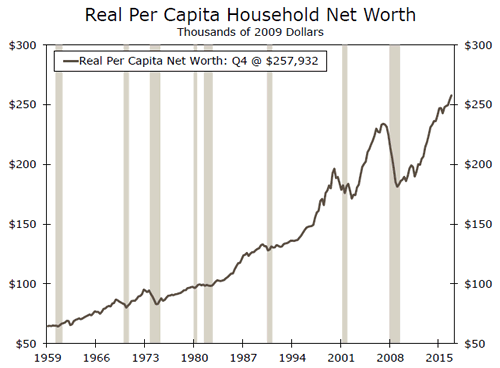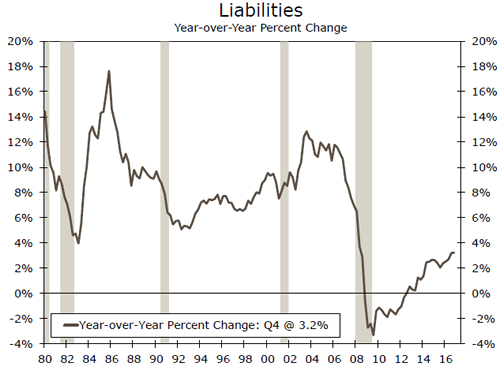U.S. Review
Calm Before the Storm
- It was a quiet data week in the United States before a slew of economic data and events next week, including a highly anticipated Federal Open Market Committee meeting.
- Job openings reached an all-time high for the series, but hiring and quits dipped, highlighting the structural challenges that remain in the labor market.
- Factory orders for April fell slightly, while the ISM nonmanufacturing survey signaled continued solid expansion in the service sector.
Calm Before the Storm
The economic data released in the United States this week were fairly light, with a full slate for next week. The most striking piece of data from this past week was the surge in job openings in April. Openings rose a sizable 259,000, surpassing 6.0 million in total and marking a new all-time high for the series (see chart on front page). This is an encouraging development, as the labor market continues to create jobs at a remarkably steady clip. Openings growth was generally broad-based, with gains in the private and public sectors. The few weak spots were concentrated in durable goods manufacturing and retail trade.
Despite the surge in new openings, hiring actually dipped in the month. As illustrated in the top chart, the job opening rate has risen dramatically since 2014, but the hiring rate has largely remained steady. The stagnation in hiring and the rising number of job openings suggest structural challenges beneath the cyclically improving labor market. A skills mismatch, uneven job opportunities by geographic region and other factors are weighing on the economy. This dichotomy between cyclical improvement and structural headwinds help explain many of the mixed signals present in today’s labor market. One encouraging development is the location of recent job opening growth: openings are up 25 percent in the Northeast and 7 percent in the Midwest, two regions that have seen relatively slower growth this expansion, outpacing the faster-growing regions of the West and South.
The ISM non-manufacturing index dipped slightly in May to 56.9 (any reading above 50 indicates expansion). The business activity and new orders components declined, but the backlog of orders component reached a cycle-high of 57.0. The survey also showed a jump in employment, although this runs somewhat counter to the May jobs report, which saw private services hiring soften for many sectors. The ISM indices have moderated slightly from their post-election spikes, but both of them remain firmly in expansion territory and above the levels that prevailed in 2016. This signals that, although economic growth in 2017 will likely fall short of the three percent plus pace some market participants hoped for in the wake of the election, growth should improve from 2016’s sub two-percent rate.
In the factory sector, the slow growth narrative for manufacturing and business spending remained intact. Factory orders fell 0.2 percent in April, but upward revisions to the March reading helped offset the decline. Core capital goods orders were modestly revised up from the March reading. As the bottom chart shows, core capital goods orders have clearly improved after a steep slide that began around when oil prices took a nose dive. After a few months of slow growth, however, core orders are growing at just a 3.8 percent three-month average annualized rate. Still, the main takeaway is that, modest as the core capital goods figures might be, they suggest that equipment spending had at least some positive momentum heading into Q2. We expect total real business fixed investment to increase at a 5.5 percent annualized rate in Q2.
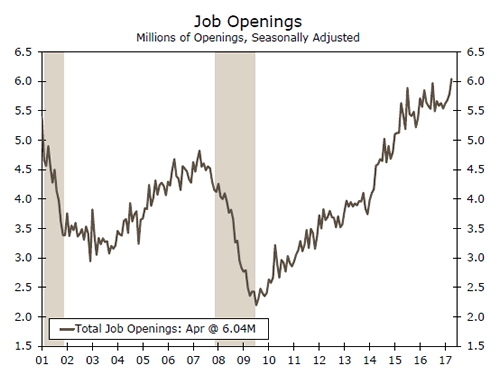
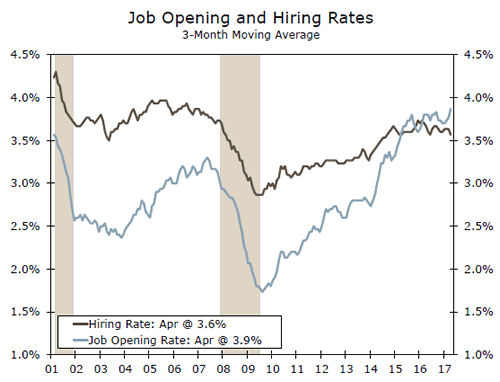
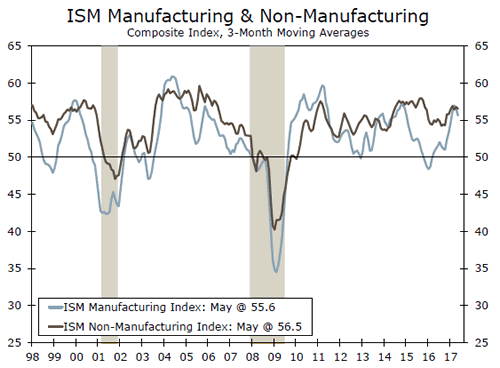
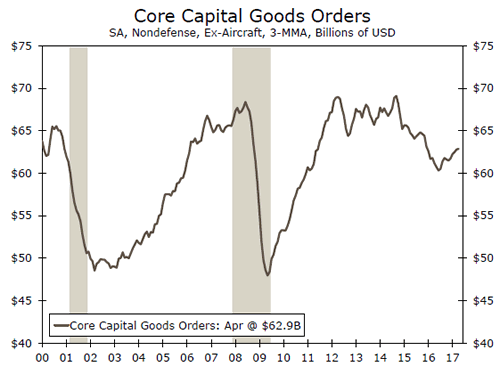
U.S. Outlook
CPI • Tuesday
The Consumer Price Index (CPI) rose 0.2 percent in April, partially recouping the prior month’s 0.3 percent loss. Energy prices, which tend to be a significant factor in the monthly headline performance, rose 1.1 percent on the month. The core CPI inflation environment remains soft, however. Core consumer prices rose a modest 0.1 percent in April, while the annual core inflation rate slipped below 2 percent for the first time since October 2015. The three-month annualized rate of core CPI has also fallen from its recent high, pointing toward further moderation in the year-overyear rate in the coming months.
We expect the CPI to be unchanged in May, with the year-over-year decreasing to 1.9 percent. While the CPI has been weaker than our initial expectations, our overall economic growth outlook remains in place, and we do not think the recent soft inflation prints will deter Fed officials from raising rates at the June meeting.
Previous: 2.2% (Year-over-Year) Wells Fargo: 2.0% Consensus: 2.0%
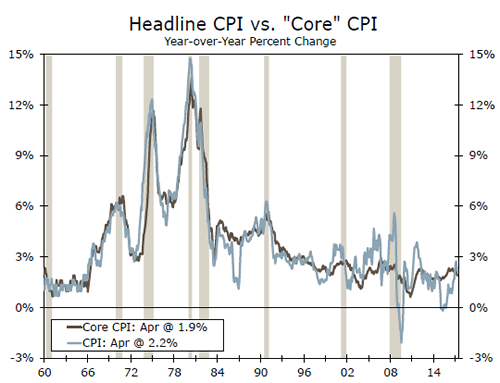
Retail Sales • Wednesday
Retail sales rose a less-than-expected 0.4 percent in April, while March’s initially reported decline was upwardly revised to a 0.1 percent gain. The headline increase was supported by rebounds in auto sales and sales at building material & garden equipment stores, which rose 0.7 percent and 1.2 percent, respectively. Nonstore retailers, which continue to benefit from the structural shift towards online purchases, also reported a strong gain. Control group retail sales rose a more modest 0.2 percent in April, although the February and March prints were revised higher.
While April’s increase in retail sales was weaker than expected, the details point to a potential acceleration of consumption in Q2. We expect retail sales to rise a modest 0.2 percent in May and look for personal consumption to increase at a 3.3 percent annualized rate in Q2.
Previous: 0.4% Wells Fargo: 0.2% Consensus: 0.1%

Housing Starts • Friday
Housing starts fell 2.6 percent to an annualized rate of 1.172 million units in April, disappointing consensus expectations for a modest gain. A 9.2 percent drop in multifamily starts accounted for the headline’s entire decline, while single-family starts inched up 0.4 percent. We expect multifamily construction to continue to slow amid lessening demand and the onslaught of apartment completions that have inundated the market in recent years.
Despite the disappointing print, housing starts for the first four months of the year are running 5.3 percent ahead of their yearago level and single-family starts are up 7.0 percent. The upward trend in single-family starts is consistent with strong readings for homebuilder confidence. We expect residential construction activity to bounce back in May, and look for the pace of housing starts to rise to a 1.207 million annualized rate.
Previous: 1.172 million Wells Fargo: 1.207 million Consensus: 1.223 million
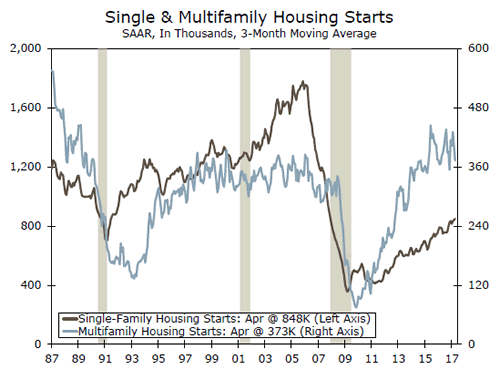
Global Review
Eurozone on Solid Footing in Q2
- The economic expansion that is underway in the Eurozone remains intact. The ECB said this week that the risks to the economic outlook "are now broadly balanced." That said, we believe that the ECB is still a long way from hiking policy rates.
U.K. Elections: Now What?
- Prime Minister May lost her gamble to increase the Tories’ parliamentary majority in Thursday’s snap election. A period of political uncertainty now settles in the United Kingdom. We expect that British economic growth will remain sluggish over the next few quarters.
Eurozone on Solid Footing in Q2
Data released this week showed that real GDP in the euro area, which originally was reported to have grown 0.5 percent (2.0 percent at an annualized rate), actually grew 0.6 percent (2.3 percent annualized) in Q1 2017 (see graph on front page). The revised data lifted the year-over-year growth rate from 1.7 percent to 1.9 percent. Moreover, the breakdown of the GDP data into its underlying demand components showed that the outturn was "good" in the sense that real GDP growth was driven entirely by growth in domestic demand.
Economic activity in the Eurozone appears to be expanding at a solid pace in the current quarter as well. Although factory orders in Germany fell 2.1 percent in April relative to the previous month, they remain up 3.5 percent on a year-ago basis (top chart). German industrial production (IP) rose 0.8 percent in April, which was stronger than expected, and March’s IP outturn was revised higher. French IP dipped 0.5 percent in April, only partially reversing the 2.2 percent surge registered in March. In general, we expect that the modest pace of expansion that is underway in the Eurozone will continue for the foreseeable future. See the "Interest Rate Watch" on page 5 where we discuss the implications of recent economic data in the Eurozone for ECB monetary policy.
U.K. Elections: Now What?
In the United Kingdom, Prime Minister May’s gamble to increase her parliamentary majority failed in Thursday’s snap election. The final tallies are not yet complete, but as of this writing it appears that the Conservative Party will fall about 8 seats short of the 326 seats needed to form an absolute majority in the House of Commons. The British pound, which fell sharply in the wake of the Brexit referendum last year, weakened against the U.S. dollar in the immediate aftermath of the election (middle chart).
The surprise election results—most observers expected that the Tories would pick up even more seats when May called the snap election on April 18—will introduce even more uncertainty into British politics. The first task will be to form a new government. The Conservative Party will need to decide whether to govern with a coalition partner or to attempt to form a "minority" government. May’s future as the leader of the Conservative Party, and hence, as the prime minister, is far from assured. Britain’s hand in the upcoming Brexit negotiations with the European Union undoubtedly has been weakened by the election results.
After growing at an annualized rate of 2.3 percent in the second half of 2016, U.K. real GDP growth slipped to 1.2 percent on a sequential basis in Q1. Incoming data suggest that growth remains lackluster in the current quarter. Although British IP edged up 0.2 percent in April, it was not enough to offset the 0.5 percent contraction registered in March. On a year-ago basis, IP was down 0.8 percent in April (bottom chart). Although the election’s outcome is probably not enough to push the U.K. economy into recession, we expect that real GDP growth will remain sluggish over the next few quarters.
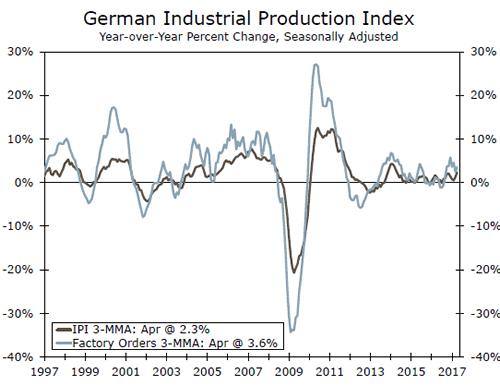
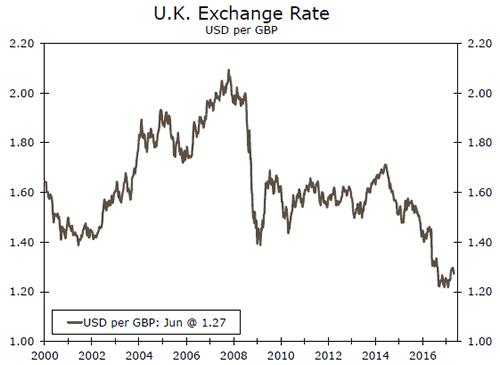
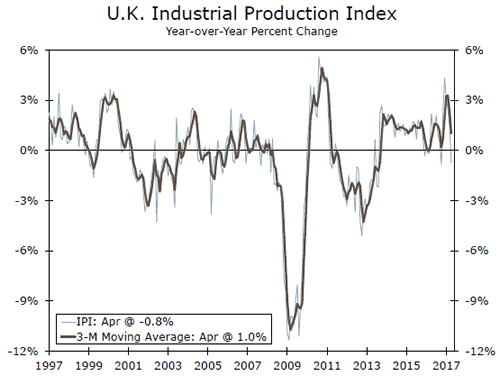
Global Outlook
Chinese Industrial Production • Tuesday
China’s industrial production (IP) undershot market expectations rising just 6.5 percent year over year in April—dropping from March’s 7.6 percent pace. The slowdown in production was due to softness in overseas demand and domestic consumption. Electricity production slowed markedly over the month signaling that much of the weakness in IP was concentrated in manufacturing output. However, the production of steel, glass and cement fared better. For May, the consensus expects overall IP growth to slow further to 6.4 percent year over year.
Next week, retail sales and fixed asset investment are also slated for release. Retail sales growth cooled in April, as muted domestic demand constrained sales. Fixed investment growth remains a shadow of its former self. The recent weakness of all three figures suggests that economic growth more than likely slowed in Q2.
Previous: 6.5% Consensus: 6.4% (Year-over-Year)
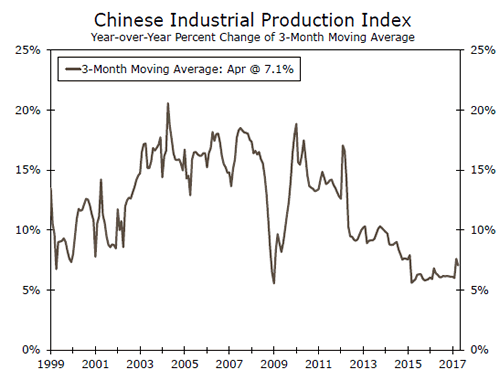
U.K. Bank of England Rate • Thursday
The Bank of England (BoE) held rates for another month in May, voting 7-1 to leave its main policy rate steady at 0.25 percent, despite rising inflation in the United Kingdom. Yesterday, voters hit the polls for an early general election. Prime Minister May lost the Conservative parliamentary majority that she was hoping to keep, creating political uncertainty as the country begins to negotiate its Brexit terms. That said, we believe that it is highly unlikely that the BoE will change its monetary policy in the near term and expect for the bank to hold rates at 0.25 percent next week.
Other data on the docket for next week include retail sales, and producer and consumer price inflation. Consumer inflation has been running ahead of the BoE’s 2 percent target for the past three months and currently sits at 2.7 percent year over year. The bank also upwardly revised its inflation forecast to 2.8 percent this year from its previous forecast of 2.4 percent.
Previous: 0.25% Wells Fargo: 0.25% Consensus: 0.25%
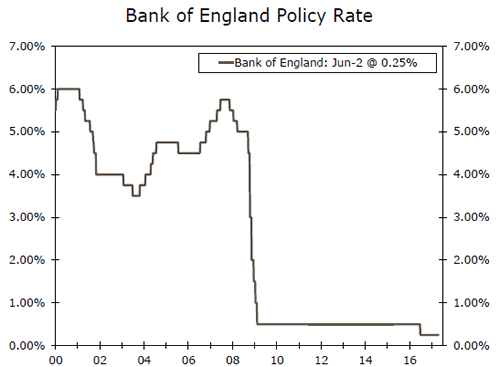
Australia Employment • Friday
Recently released data this week showed that the Australian economy expanded at a 1.7 percent annualized pace in Q1. Even with slower growth, the labor market added 37,400 jobs in April. Part-time employment accounted for all of the employment gains on the month, rising 49,000, more than offsetting the 11,000 decline in full-time employment. The participation rate held steady at 64.8 percent as the jobless rate fell two tenths of a percentage point to 5.7 percent—nearing a low not seen since 2013. Though, employment growth has been strong, wage growth, on the other hand, has been more stagnant.
That said, the forward momentum of the labor market also allowed the Reserve Bank of Australia to hold rates unchanged at 1.50 percent at its latest meeting. For May, markets look for the economy to have added 10,000 jobs.
Previous: +37,400 Consensus: +10,000
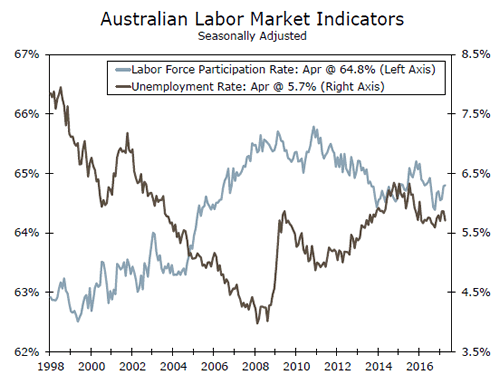
Point of View
Interest Rate Watch
ECB on Hold for Now
The European Central Bank (ECB) held a widely anticipated policy meeting this week. As expected, the Governing Council decided to keep its three main policy rates unchanged at the levels that have been maintained for more than a year (top chart). Furthermore, the Governing Council did not make any changes to its pace of bond buying, which currently totals €60 billion per month (middle chart). There was some speculation that the ECB may signal a further tapering in its quantitative easing (QE) program, but the Governing Council continued to say that it would buy €60 billion per month through the end of the year.
The Governing Council made one notable change to its policy statement. It had been characterizing the risks to the economic outlook as largely skewed toward the downside. However, the ECB upgraded its assessment and now says that the risks "are now broadly balanced." As discussed on page 4, the economic expansion that is underway in the euro area appears to be increasingly self-sustaining, hence the upgrade to the risk assessment.
The extraordinary amount of ECB policy accommodation has driven short-term interbank rates in the Eurozone into negative territory (bottom chart). Consequently, interest rates at which consumers and businesses borrow have also drifted lower. In our view, the policy accommodation that has been supplied by the ECB has contributed, at least at the margin, to the economic upswing that is currently underway in the Eurozone.
Looking forward, we believe that the Governing Council will announce further QE tapering steps this autumn and that the ECB will cease buying bonds in the first half of 2018. A rate hike seems even further afield. The statement released on Thursday acknowledged that "measures of underlying inflation continue to remain subdued." Until the core rate of CPI inflation begins to trend toward 2 percent in an unmistakable fashion, the Governing Council likely will keep rates unchanged. We do not think that the ECB will hike rates until late 2018, at the earliest.
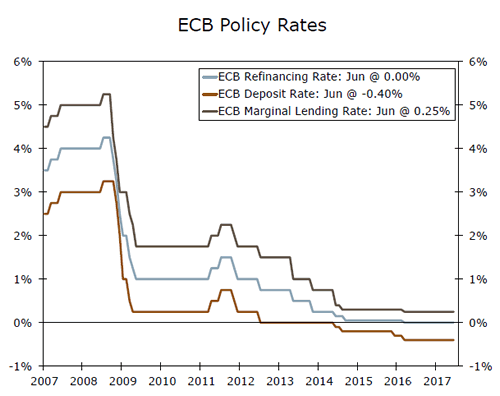
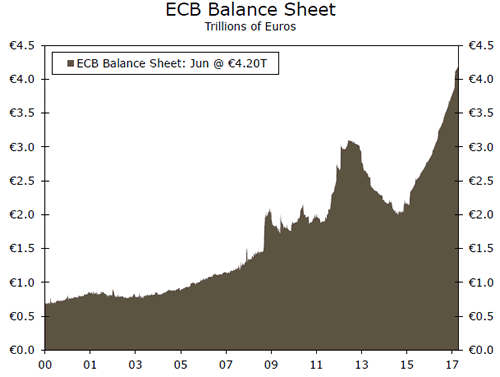
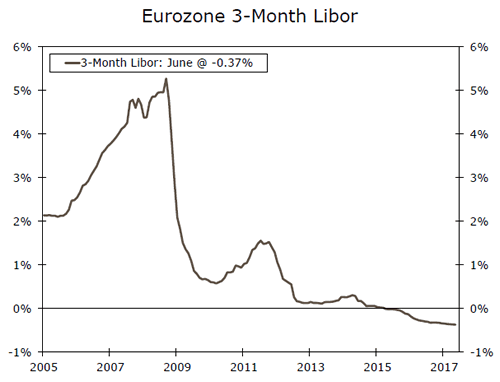
Credit Market Insights
Consumer Credit Slows in April
Consumer credit rose just $8.2 billion in April, the slowest pace since mid-2011. Nonrevolving and revolving credit growth were soft in the month, rising 2.9 percent and 1.8 percent, respectively. Growth in revolving and non-revolving credit has stabilized at around 6 percent on a year-over-year basis, a trend that has held since early 2016. This convergence makes sense as student and auto lending cool, while revolving credit plays catch-up after an unusually slow recovery.
Over the past couple years total consumer credit growth has slowed. Relative to disposable income, however, consumer credit remains elevated. At 26.5 percent of disposable income, consumer credit now represents a larger share of disposable income than it ever has since the series began in 1960.
Also at an elevated level is the percentage of nonrevolving consumer credit held by the government and Sallie Mae (the former government entity that now offers private education loans). The share now stands at 38.7 percent compared to just 10 percent in 2010. As students continue to take out loans to finance schooling and the price of education continues to climb, this share is likely only to grow. As the Federal Reserve continues on its rate tightening schedule, it will be interesting to observe the response of consumers in the credit market. Chargeoff rates saw a spike in the final quarter of 2016 – will this continue?
Topic of the Week
Household Net Worth Hits All-Time High
Household net worth soared in Q1 on the back of rising home and equity prices. Aggregate household net worth in the United States now stands just shy of $95 trillion. On an inflation-adjusted, per capita basis, household net worth was about $261,000, well surpassing the prerecession peak (top chart).
A strengthening housing market has helped homeowners on the asset side of the balance sheet. The national CoreLogic Home Price Index was up 6.9 percent on a year-ago basis in April, up from 5.5 percent as recently as January. Lean inventories and a gradual shift in the demographic fundamentals have helped spur prices higher and promote a sellers’ market. Equity markets also helped drive net worth higher: the S&P 500 rose 5.5 percent over the quarter.
On the debt side of the balance sheet, liability growth continues to pick up relative to the historically slow pace seen earlier in the expansion (bottom chart). The composition of household borrowing growth has shifted over the course of the expansion. Rapid growth in student and auto loans early in the expansion has begun to moderate, while mortgage debt and revolving credit have turned from outright contraction to steady growth.
The rise in net worth in Q1 corresponds with the continued strength in consumer confidence seen during the quarter. Yet, real consumer spending growth was a paltry 0.6 percent in Q1. It appears rising confidence and the wealth effect are being offset by other factors that drive consumer spending, such as slowing job growth and wages that have persistently failed to accelerate. Another factor to consider is that this data from the Federal Reserve is aggregate data that tells us little about the distribution of gains. If households that are seeing the bulk of the gains have a lower marginal propensity to consume, we might not see as much of a bump in short-term economic growth. We expect a rebound to 2.5-3.o percent real growth in personal consumption the rest of the year.
